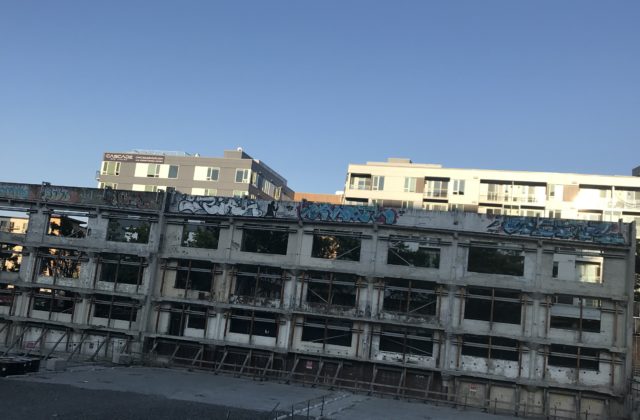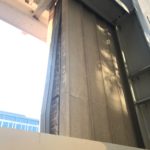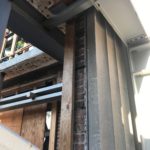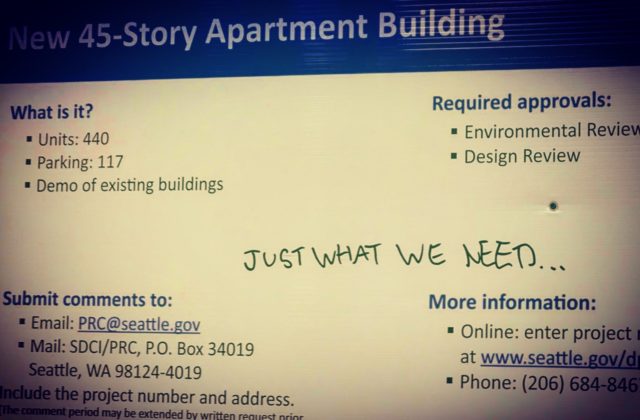Everyone! David Neiman’s Roost Project Featured in New Video
David Neiman is one of my favorite people in the housing world. And that says a lot right there. There aren’t many folks left who have the patience to engage with the system and still hang on to their principles and build housing. It isn’t easy. The incentive structure in Seattle today is slanted toward non-profit housing while people who make a living housing the vast majority of households in Seattle are told that what they’re doing is some how a bad thing. Neiman’s work has always proven them wrong. Yet Neiman is always my go to when I think the latest overreach by the City (e.g. giant garbage rooms) is absurd; when he thinks it’s absurd then I know it really is. But he keeps building great projects. Here’s a paragraph from his blog post about the video and the project part of a project with “everyone” in the title.
Ben Leiataua, the resident featured in the video, is one of the many artists who make their home at The Roost. Ben spent many years working as the marketing director for a casino before deciding to change direction and lean into the craft of singing and acting more fully. The Roost provides him with a modest home in the city from which to pursue his art in the company of other people who share his passions and interests. Ben’s work is in Seattle, but before he moved to the Roost he was living in Auburn, where he had been commuting 60 miles a day in order to find affordable rent. Ben’s story is fairly typical in that respect. Over 75% of our residents moved to The Roost from distant neighborhoods or exurbs around Seattle.
I’m not as patient as David. But it takes all kinds, right?
Making the Case for More Housing: What Would Jesus Say?
I grew up in a fundamentalist, charismatic church. We didn’t handle snakes, but there was speaking in tongues. People were “slain in the spirit.” Look it up. I probably should have been a preacher. I am good at preaching. Unfortunately, most people don’t like preaching. Now I am a baptized Episcopalian. As an Episcopalian, I have agreed to do a variety of things, like love my neighbor and repent of sins. One that is the same as the old days is to “share the Good News.” In that spirit, I wrote a post years ago called, “Where would Jesus live?” It sums up how I think my faith intersects with my advocacy for more housing. Recently, at Forbes, I posted about how absurd California is being about President Trump’s foray into “solving” the homelessness problem in California. On Facebook, someone responded to my post with a question. Maybe I should have been a comedy writer. All credit to Mel Brooks.
Facebook: Why is it so hard to get Californians (and other suburban Americans) to allow multi family housing to be constructed?
Me: That’s the right question.
We show up and say, “I know everything is pretty good in your town and your life right now. Don’t you want it to be a lot better?”
“Sure,” they say.
“Well,” we say, “the best and most sustainable way to welcome new growth is to build a lot more housing. It means things will change — but they’ll change for the better.”
“That apartment building down the street will make things better?” they ask. “But I can’t park now. And my kid walks to school that way. I heard its microhousing. Won’t that just be a big dorm for partying idiots.”
Trying not to face palm we say, “No. That new housing project will help your local cafe stay in business. That’s where those people will hang out. And it will be affordable to lots of people. You support your town being a sanctuary, right? This new project is a sanctuary for people who would have to live miles away. In fact, that barista you talk to every morning when you stop for coffee could live there.”
“Who do you work for?” they ask.
“Jesus,” we exclaim.
“Wait, what?”
The point is that spreading the Good News about housing isn’t easy. Lots of people take the housing discussion very seriously, but many really don’t want more housing. There’s a satirical post at McSweenys called, I Will Do Anything to End Homelessness Except Build More Homes. Most people on the left, especially in Seattle, wouldn’t say those words, but that’s essentially what they are advocating for when then push for taxes on housing, jobs, and rent control. All those things are great; just don’t build anything that I might see. As they say, it would be funny if it wasn’t so serious.
“Nothing but a Facade!” Historic Preservation or Waste of Money?
I have more questions than answers about the Onni project now underway where the old Seattle Times building used to be. But what I know so far, and what I’ve seen, is that an extraordinary effort is underway to preserve two corners of the facade of the old building. Taking a closer look at the work going on at the corner of Westlake and Denny. Way back in college I remember we ordered a pizza to be delivered. After waiting for an hour a friend exclaimed, “This is nothing but a facade! I don’t think the pizza is coming.” He was right. When we called the pizza delivery number we found there was no pizza order. I was gripped by the same sense of futility when I saw what’s going on at Denny and Westlake (see featured image above).
What’s going on at the site is a lot of work to build new apartments and office. Although I’m still tracking down exactly what is being built there and more details I do know that the Seattle City Council designated the facade of the building as historic. And what is the facade?
Again, I’m still researching what’s going on here, but what we’re talking about is certainly millions of dollars being spent to protect what looks like sandstone panels with regular old red bricks behind it. From a dumb guy’s perspective, on the street, it’s pretty clear that those girders and the weight are there to hold that wall in place while shoring operations are going on down below. Again, I’m just going based on what I see, but I would guess that all the labor and engineering and materials to stabilize those old walls isn’t cheap.
And shoring? I’ve always been fasciated by it. There is a really great tutorial at DCI Engineers, a Seattle based engineering firm, that lays out the basics of shoring.
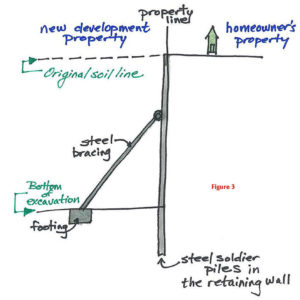
Now imagine adding the complexity of holding all that weight up while adding weight on the top of the mass being shored up. And for what? For some sandstone panels and bricks. Even if this whole operation added $25 a month to rents or $100 to monthly commercial rents is it worth it? A lot has been written about what has been termed, “facadism,” the practice of preserving the outer shell of a building and nothing else. Most of this is legal principle; there comes a point when ordering preservation of a structure amounts to seizing it, legally unsupportable. The other option for preservationists is to buy up everything in site. That’s expensive too.
When I have time, I’m going to dig more into this project with the idea of pointing out the extravagance and waste of this kind of “preservation.” It’s pointless. If you love the facade so much, disassemble it and sell it off so people can have a “piece of history.” Or buy the damn building and then you can keep it how you want it.
This is Lincoln Cathedral.

Here’s a paragraph from ol’ Wikipedia about the cathedral.
It was the tallest building in the world for 238 years (1311–1548), and the first building to hold that title after the Great Pyramid of Giza.[2][3][4] The central spire collapsed in 1548 and was not rebuilt. For hundreds of years the cathedral held one of the four remaining copies of the original Magna Carta, now securely displayed in Lincoln Castle. The cathedral is the fourth largest in the UK (in floor area) at around 5,000 square metres (54,000 sq ft), after Liverpool, St Paul’s and York Minster.[5] It is highly regarded by architectural scholars; the Victorian writer John Ruskin declared: “I have always held … that the cathedral of Lincoln is out and out the most precious piece of architecture in the British Isles and roughly speaking worth any two other cathedrals we have.”
Would I lie down in front of the bulldozers if someone wanted to build housing at Lincoln on that site. Yes. Yes, in a heartbeat. When you look at the walls of the structure you can see almost a thousand years of history. The Showbox? The Seattle Times Building? I’ll drive the bulldozer myself. Just give me the keys and a hardhat. The decision is easy. We simply can’t keep “preserving” things simply in order to complicate, and slow down things that we don’t want. It makes housing more expensive, eats up working people’s pay checks, and is abusive of real preservation efforts.
Forbes: Housing Always Comes Back to Narrative
I have two posts at Forbes from last week that I think hinge on the story we tell about housing.
Is It Time For “Housing Vigilantism?”, is really about asking and answering the question, “What does a community do when local government fails to take care of essential functions?” In this case, some people in Oakland have taken filling potholes into their own hands. For thousands of dollars they are fixing city streets. What did the City do? Propose a program that would pay union labor millions to do the same thing. The analogy with housing is hard not to make. Why deregulate the housing economy and allow private business to solve a big part of the housing scarcity problem when you can tax new housing, give the money to politically powerful non-profits who will produce a fraction of the housing for as much as twice the price?
There Is An Addiction To Bad Narratives About Homelessness, is a response to a Crosscut post that kind of makes my point that you find out where a person’s politics are when that person tells you what causes homelessness. If someone says that jobs cause homelessness you know that that individual thinks that there is one pie divided among a growing population; if your slice is bigger it is because mine is smaller. If someone says it is drugs that cause homelessness you’re likely talking to a neighbor who opposes new housing development and thinks homeless is a law enforcement issue. The problem is that we don’t even really know what we mean by “homelessness,” and neither of these causes or solutions gets at the point: we can do more to ease the suffering of people with less money and housing issues by building more housing.
Just What We Need…..More Housing!
There’s not much to say here other than to show you some pictures. I took the first two walking home.
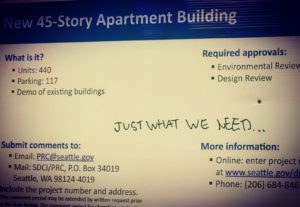
Is this an affirmation? Or is it just dripping with sarcasm? I think it’s pretty obvious. And just down the street was this:
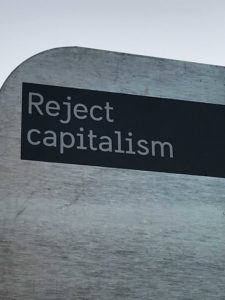
Ok. Capitalism, I reject you!
And then there is this, an advertisement that popped up in a news story about the G7 conference.

This apartment is giving away a free month of rent.
I leave it to you to decide what to make of these images. What we do need is more housing. As for capitalism, it is, I’m sorry to break it to people, an ideology but a fact of life. People want more than they have. That drives innovation, speculation, and, yes, more housing development. That’s how you get an offer like, “One Month Free!” If we truly believe that price is the problem then we’d be happy, not sarcastic, when we saw new apartments coming. Maybe it’s “oversimplifying” as someone said recently to suggest that more is better. I don’t think so. It really is that simple. More means lower prices. It’s just what we need!


